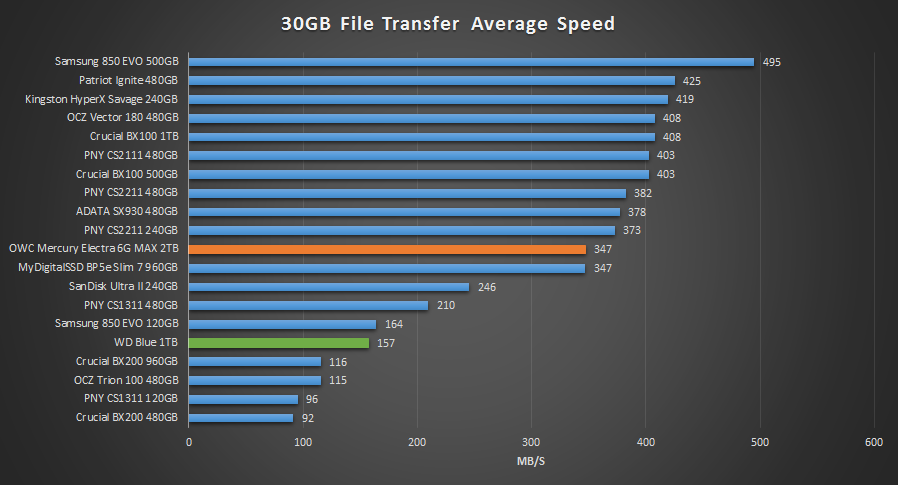REAL WORLD FILE TRANSFER
Finally, we wanted to see how performance was in a real world use when transferring large files to the SSDs. For this test we are going to simply stress write performance by transferring over a 30GB folder of movies off of one SSD to this one and time how long it takes. Once complete we can calculate the average speed.

Here we can see that the speed was not as good as we were hoping for, but still not as bad as most TLC drives out there. After continual use and ample time for garbage collection to take place after PCMark 8, the OWC Mercury Electra 6G MAX was able to write at only 347MB/s average rather than over 400MB/s as rated for.
POWER CONSUMPTION
For our power consumption testing, we have the drive connected to the system as a secondary drive. To record the wattage, we are now utilizing a Quarch Technology Programmable Power Module. It allows us to accurately measure power consumption over time and is flexible enough to allow us to test any SSD that comes our way.
Our power analysis may change as time goes on, but for now we are looking at just a few metrics with the main goal of measuring our results against the manufacturer’s ratings. One, idle power consumption. Because most consumer systems are at idle for about 80% of the time, idle power consumption is an important measure to look at when understanding the efficiency of a drive. Next we look at startup consumption. This tells you how much power the device needs during startup and while it is usually more important when looking at HDDs and enterprise class storage, it is still something worth quantifying. After that we did averaged out the active power consumption from the 30GB file transfer. Finally, we went through our power logs during testing and listed the maximum power draw.

The OWC Mercury Electra 6G MAX is power hungry compared to many other SSDs. The additional RAID chip and second SSD controller draw a lot more power at idle especially. The maximum power consumption was over 8W! The average file transfer wattage was just over 6W and startup consumption spiked to almost 6.5W. Overall, we can see that this SSD is quite power hungry.
Finally, we wanted to post up a graph of the difference in idle power consumption between many of the current SSD options in the market. Again, idle accounts for the majority power draw of a drive and considering the use a drive in laptop, idle power consumption can greatly affect battery life, therefore we feel we should compare it in its own graph.

Finally, idle power consumption as we can see is 1.91W, which is three times more than any SATA SSD we have tested above. This is more in the range of PCIe based SSDs such as the Kingston HyperX Savage’s idle power consumption.
 The SSD Review The Worlds Dedicated SSD Education and Review Resource |
The SSD Review The Worlds Dedicated SSD Education and Review Resource | 
What a pointless config. Not only this is more expensive to make, it’s slower than using a single controller.
They should have just went with Phison S10, which natively supports 2TB of storage and is faster than this.
From OWC Mercury Electra 6G I learned that ‘SSD’ actually stands for “Super Sudden Death”. I lost all my stuff, because it died right in the middle of backup. Thank you ‘OWC’. No more anything from OWC in my MBP 13″ late 2011. Never ever!